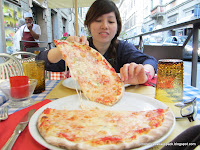Day 15
The city night line from Munich arrived at Amsterdam about 30 minutes
late. From Amsterdam Centraal, we took the tram to Shelter Jordan Christian Youth Hostel. It’s a Christian hostel but
you don’t need to be one to stay there.
We wanted to tour Amsterdam in a bicycle so we rented from the hostel
for an entire day. What we didn’t expect though was how tall the bicycles were.
The Dutch are tall and fit people. The bicycles were too big for us. We did a
test run for a few blocks but we found it hard to start and stop since we
couldn’t reach the floor, even with heels. The hostel manager saw how we
struggled with the bikes and since there were no smaller bicycles available, he
was kind enough to give us a refund. So, we decided to just explore Amsterdam
on foot.
 |
| I amsterdam at Musemplein |
We found our way to Museumplein.
This is the park with the I amsterdam
sign. As touristy as it may sound, taking a photo on top of one of its letters
was on my must-do list. But hey, I am
a tourist. So, in my heels, I climbed the letter “a” and did my pose.
 |
| Canal Cruise |
 |
| Munttoren |
A pleasant way to explore Amsterdam was through a canal cruise (9 EUR). There are more or less as much canals in Amsterdam as
there are streets. The canal tour had a pre-recorded commentary in four
languages, English being one of them. While Venice has one Grand Canal,
Amsterdam has four main canals: Prinsengracht, Herengracht, Keizersgracht and
Singel.
Our eyes feasted on the 17th century houses and the fascinating
boat houses along the canals. There was actually a time when housing was
difficult in Amsterdam that the city allowed people to live on boats, docked in
the canals. Can you imagine having your address here?
 |
| Ship replica of Scheepvaartmuseum |
We passed by Magere Brug,
popularly known as the Skinny Bridge.
It’s a traditional double-leaf draw bridge. Originally built in 1670, what used
to be a narrow bridge was widened to allow more traffic. The bridge opens up
every couple of minutes to allow boats to pass through. We passed by several attractions
including the Munttoren (Mint Tower),
Sint Nicolaaskerk (Church of Saint
Nicholas) and Het Scheepvaartmuseum (National
Maritime Museum). Much to our dismay, Angela’s memory card went full while mine
was back at the hostel, recharging.
 |
| Sint Nicolaaskerk |
 |
| De Gooyer Windmill |
We headed back to the hostel to grab my camera and continued to De Gooyer Windmill. Angela’s must-see
in Amsterdam was a windmill and our Amsterdam City Spy Map highlighted this
particular windmill. We spent a lot of time trying to find a way to get to this
windmill. Apparently, some of the bus/tram lines were not operational that day.
When we arrived at the windmill, it is now actually a brewery. No wonder, when
I asked how to get there, the bus driver told me not to drink too much!
Finally, the last place in our itinerary was the Red Light District at De
Wallen. Using the GPS, we found our way by foot to the red lights from
Amsterdam Centraal. I was tempted to buy a bar of chocolate with some herbal
hallucinogens but knowing I might get into trouble when I leave Amsterdam the
next day, I had to say no. We passed by a shops selling… toys (haha!) and a
street of window prostitution. Curiosity sated.
Months before, Angela and I planned on drinking, smoking and partying
in Amsterdam. After all, this was our last night together. Angela had to go
back home while I was going to continue to… I haven’t decided yet at that point
where I was going. But that night, we went home relatively early (before
midnight) and didn’t drink a drop of alcohol. Nevertheless, we were high on our
experiences.
















































